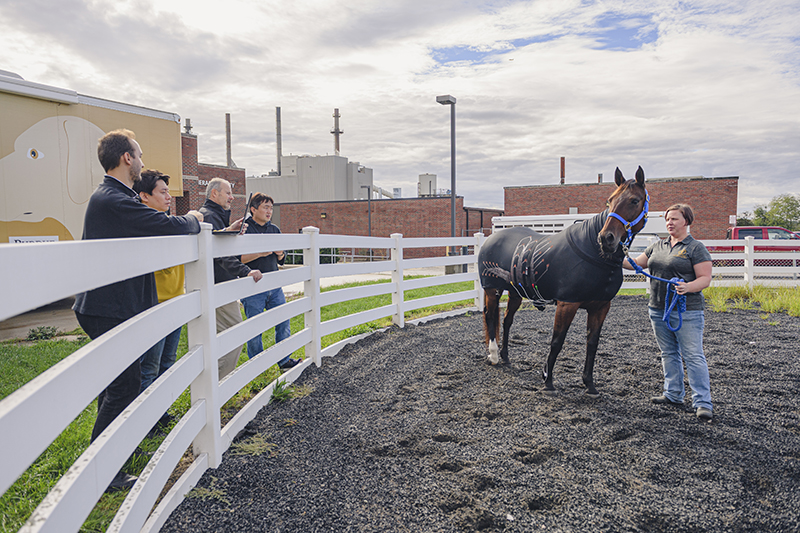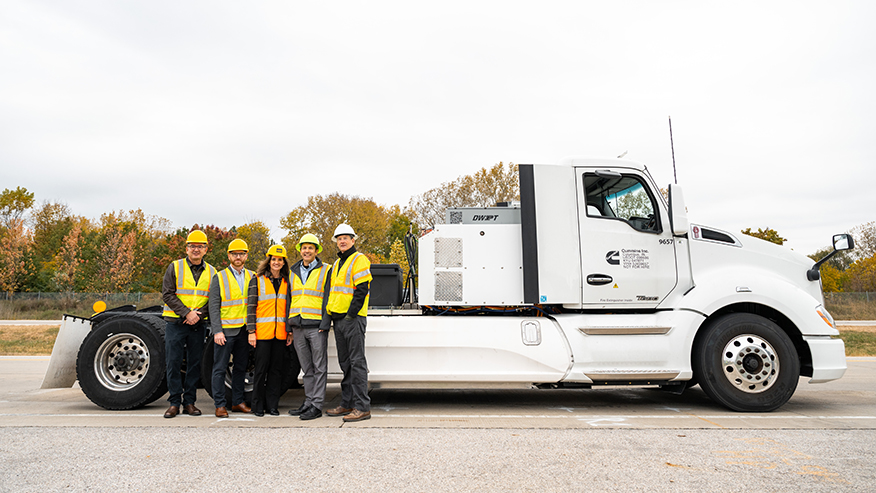A horse slicker is just a horse slicker, of course, of course, unless it can monitor chronic disease
Next hurdle: Designing for other large animals, humans

Professors Chi Hwan Lee (right) and Laurent Couëtil (left) chat while observing a cardiac, respiratory and muscular test on a horse named Leila at Purdue University’s College of Veterinary Medicine. Graduate students Semih Akin (left) and Taehoo Chang (right) capture the horse’s vital signs on a laptop via Bluetooth technology from a specially designed horse slicker. Laura Murray, research technologist in the College of Veterinary Medicine, is with Leila. (Purdue University photo/Rebecca McElhoe)
WEST LAFAYETTE, Ind. —
With the exception of Mister Ed of television sitcom fame, horses can’t talk with humans about health issues.
Now, a first-of-its-kind horse slicker with a specially designed liner could be able to “tell” the horse’s human caregivers of increasing chronic diseases.
A new study by Purdue University engineers and veterinarians explores how to convert off-the-shelf horse slickers into e-textiles that continuously monitor equine cardiac, respiratory and muscular systems for several hours under ambulatory conditions.
The study is published in the journal Advanced Materials.

To add the e-textile capabilities to the slicker, the Purdue team developed a dual regime spray and technique to directly embed a pre-programmed pattern of functional nanomaterials into the slicker’s fabrics. To enable remote monitoring, the e-textile was connected to a separate portable unit that shared vital signs to a laptop via Bluetooth.
Using the e-textile means that veterinarians and their support staff won’t have to shave the horse’s hair or use messy adhesives to place the electrode on the horse’s skin, which makes it more comfortable for the horse.
Chi Hwan Lee, the Leslie A. Geddes associate professor in Purdue’s Weldon School of Biomedical Engineering, said continual monitoring through the e-textile patterns can be useful for long-term management of chronic health conditions in large animals and eventually humans. Lee also has a joint appointment in the School of Mechanical Engineering and a courtesy appointment in the School of Materials Engineering.
According to Lee, adding e-textile properties to existing garments helps scientists, researchers and clinicians take advantage of garments’ already-existing ergonomic designs to secure a commercial grade of wearability, comfortability, air permeability and machine washability.
“These specially designed e-textiles can comfortably fit to the body of humans or large animals under ambulatory conditions to collect bio-signals from the skin such as heart activity from the chest, muscle activity from the limbs, respiration rate from the abdomen or other vital signs in an extremely slight manner,” Lee said. “Our technology will significantly extend the utility of e-textiles into many applications in clinical settings.”
The team’s next steps involve developing continuous 24-hour monitoring of horses with chronic disease or those receiving care in a veterinary ICU.
“We believe that our technology will be helpful in diagnosis or management of chronic diseases,” Lee said, especially as demand increases for remote health monitoring.
“Remote health monitoring under ambulatory conditions would be useful for farm and household animals, as it could potentially minimize clinic visits, especially in rural areas. It would also increase the efficiency in managing a large number of farm/household animals at once from a distance, even overnight,” Lee said.
A real-life example would be the ability to monitor severe equine asthma, which affects 14% of adult horses.

“Continuous monitoring would allow early detection of disease flair-up before it gets serious, offering an opportunity to nip it in the bud,” said Laurent Couëtil, a professor of large animal internal medicine in Purdue’s College of Veterinary Medicine and collaborator in the study. “Remote monitoring opens the possibility of sending vital information to the veterinarian to help make timely and informed treatment decisions.”
The Purdue research team also included Martin Byung-Guk Jun, an associate professor of mechanical engineering in the School of Mechanical Engineering; Taehoo Chang of the School of Materials Engineering; Semih Akin, Bongjoong Kim and Sengul Teke of the School of Mechanical Engineering; Laura Murray of the College of Veterinary Medicine; and Seungse Cho, Sena Huh and Min Ku Kim of the Weldon School of Biomedical Engineering.
The Purdue Research Foundation Office of Technology Commercialization has filed a patent for the technology. Funding came from the National Institutes of Health National Institute of Biomedical Imaging and Bioengineering (1R21EB026099-01A1), the National Science Foundation Civil, Mechanical and Manufacturing Innovation (1928784) and the SMART Films Consortium in Purdue’s Birck Nanotechnology Center, located in Discovery Park.
This work is part of Lee’s focus in developing platform technologies using sticktronics, which are sticker-like items that contain electronics or smart technology. Sticktronics offer the ability to physically separate supporting substrates in existing electronic items and turn an item into a sticker that can be more flexible or transparent, especially on curved displays and biomedical sensors. Lee also specializes in custom-printed soft medical sensors and conformable sensor arrays, all of which can transform telemedicine and on-demand drug delivery systems.
About Purdue University
Purdue University is a top public research institution developing practical solutions to today’s toughest challenges. Ranked in each of the last four years as one of the 10 Most Innovative universities in the United States by U.S. News & World Report, Purdue delivers world-changing research and out-of-this-world discovery. Committed to hands-on and online, real-world learning, Purdue offers a transformative education to all. Committed to affordability and accessibility, Purdue has frozen tuition and most fees at 2012-13 levels, enabling more students than ever to graduate debt-free. See how Purdue never stops in the persistent pursuit of the next giant leap at https://purdue.edu/.
ABSTRACT
Programmable Dual Regime Spray for Large-Scale and Custom-Designed Electronic Textiles (Advanced Materials)
Taehoo Chang, Semih Akin, Min Ku Kim, Laura Murray, Bongjoong Kim, Seungse Cho, Sena Huh, Sengul Teke, Laurent Couëtil, Martin Byung-Guk Jun, Chi Hwan Lee
https://doi.org/10.1002/adma.202108021
Increasing demand for wearable healthcare synergistically advances the field of electronic textiles, or e-textiles, allowing for the ambulatory monitoring of vital health signals. Despite great promises, the pragmatic deployment of e-textiles in clinical practice remains challenged due to the lack of a method in producing custom-designed e-textiles at high spatial resolution across a large area. To this end, we employ a programmable dual regime spray that enables the direct custom writing of functional nanoparticles into arbitrary fabrics at submillimeter resolution over meter scale. The resulting e-textiles retain the intrinsic fabric properties in terms of mechanical flexibility, water vapor permeability, and comfortability against multiple uses and laundry cycles. The e-textiles tightly fit various body sizes and shapes to support the high-fidelity recording of physiological and electrophysiological signals on the skin under ambulatory conditions. Pilot field tests in a remote health monitoring setting with a large animal, such as a horse, demonstrate the scalability and utility of the e-textiles beyond conventional devices. This approach will be suitable for the rapid prototyping of custom e-textiles tailored to meet various clinical needs.
Writer, Media contact: Matthew Oates, 765-586-7496 (cell), oatesw@purdue.edu, @mo_oates
Sources:
Chi Hwan Lee, lee2270@purdue.edu;
Laurent Couëtil, couetill@purdue.edu;
Taehoo Chang, chang466@purdue.edu
Note to journalists:



